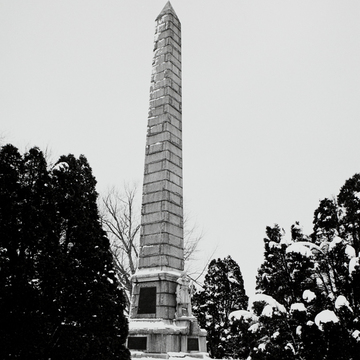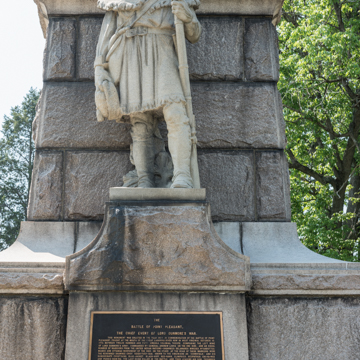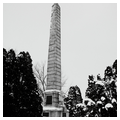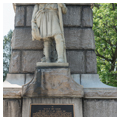This rough-hewn granite obelisk commemorates the daylong battle that occurred here on October 10, 1774. It also commemorates Livia Simpson-Poffenbarger's tireless efforts to have the nation recognize the importance of the engagement, which she considered the first battle of the American Revolution. Her persistence paid off when the U.S. Congress appropriated $10,000 for the monument in 1908. Armed with additional funds, the Ladies Monument Association contracted with Boston's Van-Amringe Granite Company, which had also erected monuments at Gettysburg, to furnish plans and specifications. For $16,000, including shipment and erection, the ladies ordered “a monument of Balfour granite, the statue thereon to be of Westerly granite. The shaft is an obelisk with a base twenty-four feet square, the height to be eighty-two feet. The statue is to be that of a colonial soldier of the primitive Virginia style, dressed in hunting shirt, coon skin cap, leather breeches and long rifle.” One hundred fifty-two
An 8-foot granite soldier with a coonskin cap in his right hand and a long rifle in his left faces eastward in “at ease” position at the monument's base. The Smith Granite Company of Westerly, Rhode Island, provided the statue. Albert Russell and Sons of Newburyport, Massachusetts, cast the bronze plaques that detail the history of the battle and list the names of its participants. The monument, one of West Virginia's earliest and still one of its largest memorials, dominates the point where the Kanawha flows into the Ohio. Whether it commemorates the first battle of the American Revolution is another matter.
Also on the grounds are monuments to Chief Cornstalk, reinterred here in 1909, and “Mad Anne” Bailey (1742–1825), a popular pioneer heroine whose exploits have been so blown out of proportion over the years that it is hard to separate fact from myth. Near the Ohio riverbank a plaque identifies the site where French explorer Pierre-Joseph Céloron de Blainville buried a lead plate on August 18, 1749, claiming the Ohio, or Belle Rivière, for France. It was uncovered almost a hundred years later.




